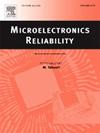A comparative study between the improved unified creep-plasticity model and Anand model: Experimental investigations at the material-scale and packaging structure-scale
IF 1.9
4区 工程技术
Q3 ENGINEERING, ELECTRICAL & ELECTRONIC
引用次数: 0
Abstract
With the increasing miniaturization and complexity of electronic packaging, accurately characterizing internal mechanical responses through finite element simulation has become crucial for reliability assessment. This study comparatively evaluates the damage-coupled Unified Creep Plasticity (UCP) model and Anand model in simulating solder joint behavior under cyclic loading across material and structural levels. Material-level simulations of the SAC305 alloy under uniaxial tension-compression reveal that the damage-coupled UCP model yields smoother stress-strain curves with better experimental agreement, while the Anand model exhibits folded inflections near yield points, showing 12 % strain deviation. Structural-level analysis employing silicon-embedded stress sensors demonstrates that the UCP model's stress evolution correlates strongly with experimental measurements, whereas the Anand model shows 15–20 % peak stress deviations. Three-dimensional flip-chip BGA modeling further clarifies mechanistic differences: The Anand model omits plastic phase evolution, only capturing elastic and creep stages, while the UCP model fully describes three-phase evolution (elastic-plastic-creep), accurately reflecting actual deformation mechanisms. These multi-scale results validate the UCP model's superiority in characterizing visco-plastic behavior of solder joints, providing critical theoretical support for packaging reliability optimization.
改进的统一蠕变塑性模型与Anand模型的比较研究:材料尺度和包装结构尺度的实验研究
随着电子封装小型化和复杂性的不断提高,通过有限元模拟准确表征内部力学响应已成为可靠性评估的关键。本研究比较评估了损伤耦合统一蠕变塑性(UCP)模型和Anand模型在模拟跨材料和结构水平循环加载下焊点行为的效果。单轴拉压下SAC305合金的材料级模拟结果表明,损伤耦合UCP模型得到的应力-应变曲线更平滑,实验一致性更好,而Anand模型在屈服点附近出现折叠弯曲,应变偏差为12%。采用硅嵌入应力传感器的结构分析表明,UCP模型的应力演化与实验测量结果密切相关,而Anand模型显示15 - 20%的峰值应力偏差。三维倒装BGA模型进一步澄清了机理差异:Anand模型忽略了塑性阶段的演化,只捕捉了弹性和蠕变阶段,而UCP模型则完全描述了弹塑性蠕变阶段的演化,准确反映了实际的变形机制。这些多尺度结果验证了UCP模型在表征焊点粘塑性行为方面的优势,为封装可靠性优化提供了重要的理论支持。
本文章由计算机程序翻译,如有差异,请以英文原文为准。
求助全文
约1分钟内获得全文
求助全文
来源期刊

Microelectronics Reliability
工程技术-工程:电子与电气
CiteScore
3.30
自引率
12.50%
发文量
342
审稿时长
68 days
期刊介绍:
Microelectronics Reliability, is dedicated to disseminating the latest research results and related information on the reliability of microelectronic devices, circuits and systems, from materials, process and manufacturing, to design, testing and operation. The coverage of the journal includes the following topics: measurement, understanding and analysis; evaluation and prediction; modelling and simulation; methodologies and mitigation. Papers which combine reliability with other important areas of microelectronics engineering, such as design, fabrication, integration, testing, and field operation will also be welcome, and practical papers reporting case studies in the field and specific application domains are particularly encouraged.
Most accepted papers will be published as Research Papers, describing significant advances and completed work. Papers reviewing important developing topics of general interest may be accepted for publication as Review Papers. Urgent communications of a more preliminary nature and short reports on completed practical work of current interest may be considered for publication as Research Notes. All contributions are subject to peer review by leading experts in the field.
 求助内容:
求助内容: 应助结果提醒方式:
应助结果提醒方式:


